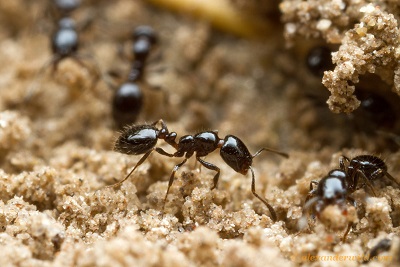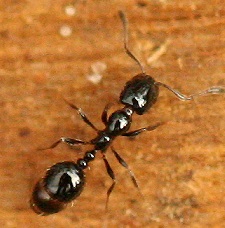Form and Function
Monomorium minimum has a form that makes it advantageous within its society. It has many different distinct features that help it adapt and function within its environment. Without these crucial characteristics these organisms would have a hard time surviving. These ants are seen as teeny workers (Adams and Traniello 1981).
The species M. minimum have many attributes that help it to
be a successful species. The ant’s abdominal region is made of two
sections and they have a lengthy and large head (Smith 1965). The ants
are mainly black and brown, out of these two colors they are most often
recognized as black (Smith 1965,Texas A&M AgriLife Research
Extension 2010). The body of the M. minimum is
close to being completely smooth and sleek except in just a few
locations (Smith 1965). The M. minimum uses structures called clypeus
and carinae as its form of teeth and has an antenna that is segmented
with a club that is also segmented (Smith 1965,Texas A&M AgriLife
Research Extension 2010 ). M. minimum also has a
mesoepinotal which is a clear-cut tight region on the ant (Smith 1965).
Finally, M. minimum has a prothorax which contains spherical
humeri (Smith 1965).
M. minimum are quite small, these ants are workers and are
1.5-2 mm in length; each ant contains a structure called a sting (Smith
1965, School of Ants 2011). The sting is used by the M. minimum as a repulsive toxin to keep
competition away (Adams and Traniello 1981). The sting gives the
M. minimum an advantage over other species and a method that
they can use in order to fight back (Adams and Traniello 1981).
The ants have a venom gland that holds the trail pheromone which is
used as a guiding tool by the ants to various food sources (Mashaly
2010). The gland is called the Dufour’s gland and the amount of
ants that react to the paths made by pheromone depends on how
concentrated the pheromone is within the path (Adams and Traniello
1981). Finally the organism moves at a slow pace in comparison to other
ants, moving at a pace of around 7 mm/sec (Pearce-Duvet et al. 2011).
The ant has various structures that help it compete with other organisms
and that help it gather food in order to survive.
M. minimum have many different adaptations and structures
that help them interact to their environment and its different
challenges. M. minimum can recruit amongst themselves for help with the
breakdown of large food particles into smaller pieces and can make a
chemical toxin that keeps competition away during this process (Adams
and Traniello 1981, Resh and Cardé 2009). They function together as a team in order to make
the large food particle into smaller food particles that they each can
carry by themselves (Adams and Traniello 1981, Resh and Cardé 2009). This is helpful because
 the organism M. minimum will only carry pieces of food by itself rather
than a bunch of ants working together in order to carry the same large
piece of food (Adams and Traniello 1981). In order to break the piece
of food that is too large for a lone ant to carry by themselves, the
M. minimum use their mandibles while carving the dead arthropod
(Adams and Traniello 1981).
the organism M. minimum will only carry pieces of food by itself rather
than a bunch of ants working together in order to carry the same large
piece of food (Adams and Traniello 1981). In order to break the piece
of food that is too large for a lone ant to carry by themselves, the
M. minimum use their mandibles while carving the dead arthropod
(Adams and Traniello 1981).
M.minimum are great at adapting to different conditions. They adapt well to different forms of nutrition and by how they form their nests (Smith 1965). The different aspects of the form and function of the M. minimum can help it be better suited for its particular environment. The ability of the ant to use its form and various features to its advantage helps to keep the organism alive on a day to day basis making sure that it has the tools it needs in order to gain more benefits in a certain environment.
Want to know how these little organisms multiply? Click here for Reproduction details.
Click here for References.
Click here to return to the Home page.

